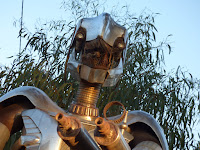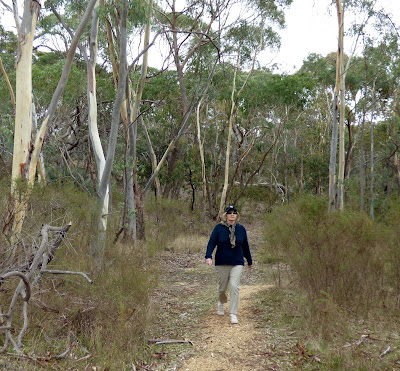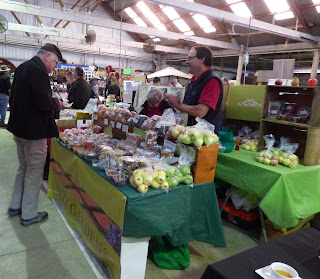Then we reached Eden Valley, a wine area just south of the Barossa heartland. Here the autumn colours were in full swing.
And onto the Barossa.
For those who love to know why things are so-named...
Colonel Light, Adelaide's first Surveyor General, visited the region in 1837 and named the valley Lynedoch Valley after his friend Lord Lynedoch; he named the surrounding hills the Barrosa Ranges because they reminded him of the area in Spain where he and Lynedoch had fought in the Battle of Barrosa. Misspellings occurred, and eventually Barossa was the name applied to the whole region, and Lyndoch, to a small nearby settlement.
The valley was settled largely by German Lutheran immigrants in the 1840s, and there is still a distinctive Germanic feeling in the area, as evident by this imposing sign.
We visited the major towns of Angaston (named after London merchant George Fife Angas who encouraged the German Lutherans to migrate to South Australia to escape religious persecution) and Tanunda (an Aboriginal word meaning 'water hole'), both full of good food places, lovely old houses and heritage buildings.
 |
| A 1930s house in Angaston |
 |
| A typical Tanunda dwelling |
 |
| The home of Johann Rieschiek, a shoemaker, this is one of the oldest houses in Tanunda. |
This next photo is cheating because we never actually went into this building in the Tanunda Recreation Park; the photo was on an interpretive panel. It was closed when we were there, but I loved its story which is why I have included it. It is a kegelbahn or skittle alley. The game of kegel was a forerunner of 10-pin bowling and the Tanunda club was formed on 1858. It is the only one of its kind in the southern hemisphere.

Quirky roadside art in Angaston.

Then it was off for some serious wine tasting.
We visited Jacobs Creek, one of the biggest wineries, in a lovely setting surrounded by gum trees.

A favourite of ours was Bethany Wines in the tiny hamlet of Bethany.
Bethany was the first village in the Barossa settled by Prussian immigrants in the 1840s and the main street is full of old cottages, barns and age-old gardens.
The Bethany cemetery was the last resting place for many of the German settlers; the children's section was heartbreaking as the headstones recorded stillbirths, day-old children and not many past one year old.
A more pleasant diversion was a visit to Pheasant Farm and the farm shop of well-known South Australian foodie Maggie Beers where I swooned over fig and fennel paste, raspberry jam, beetroot relish, pate, Seville marmalade, and much more. We walked around the lake.
The gentle views made for a relaxing visit.
Back on the wine trail and we loved the ambience (and the wines) at Rockford Wines.

 |
| A food platter at Grant Burge Wines. |
The Kaiserstuhl Conservation Park is part of an old remnant Barossa forest, little of which remains today. There were stirngybarks, red river gums,grass trees, banksias, wattles and heaths and granite outcrops.
I loved looking for details.
Another diversion took us to a lookout and a sculpture park, displaying the works of six sculptors from Australia, Japan, Belgium, France and the USA.
 |
| I think this was called White Cloud. |
And so ends our trip to the Barossa Valley. Lots of lovely memories of golden vistas...
... rows of vines stretching to the horizon...

and, back home, part of our horde displayed on the kitchen bench.






































The vines look beautiful at this time of the year...
ReplyDeleteSculptures are not my cup of tea...
You bought quite a diverse range, there...
I love the White Cloud sculpture! I'm trying to remember the name of the sculpture park The Easterers visited the year we stayed in Angaston. Eludes me. And only one of the works looks familiar.
ReplyDeleteYou obviously had a fabulous time. All that Ommmming the day before would have helped. XXXX
waoo well written post about Autumn in the Barossa Valley
ReplyDeleteThanks,
Crude Oil Trading Tips | Gold Jackpot Call